BTEC HND Level 5: Research Project on the Effects of Smoking
VerifiedAdded on 2023/06/14
|51
|14074
|68
Project
AI Summary
This research project investigates the detrimental effects of cigarette smoking on human health, focusing on its impact on various organs and the development of associated diseases. The study begins with a research proposal outlining the planned research activities, followed by a systematic review of existing literature and primary research involving interviews and surveys with smokers. The primary research aims to assess the effects of smoking on their health and their awareness of these effects. The project covers topics such as the mechanisms by which smoking affects the body, the impact on physical and mental health, and the effects on overall quality of life. The research employs both secondary and primary data collection methods, including interviews and surveys, to provide a comprehensive analysis of the health consequences of smoking.
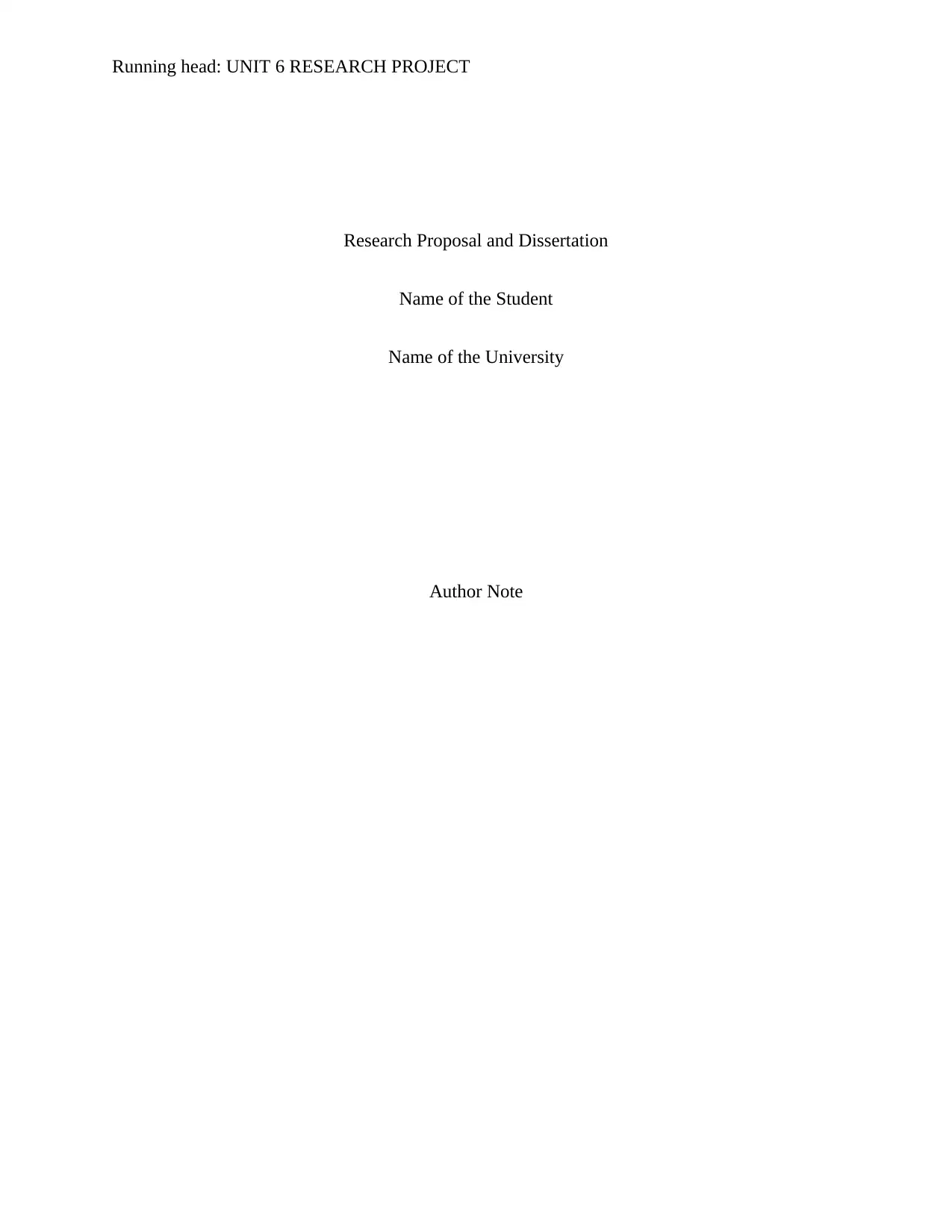
Running head: UNIT 6 RESEARCH PROJECT
Research Proposal and Dissertation
Name of the Student
Name of the University
Author Note
Research Proposal and Dissertation
Name of the Student
Name of the University
Author Note
Paraphrase This Document
Need a fresh take? Get an instant paraphrase of this document with our AI Paraphraser

1UNIT 6 RESEARCH PROJECT
Executive summary
Cigarette smoking is found to harm almost every organ of the human body, and results in the
formation of a plethora of diseases that reduce the health and wellbeing of all smokers in general.
The effect of tobacco varies from person to person. The ways by which nicotine, the primary
chemical present in tobacco plant affects the physiological system of a person depends on a
range of factors that include their weight, size, and health. Smoking is found to generally exert
multiple negative health effects. Owing to this fact smoke inhalation is considered to inherently
poses a range of challenges to the various physiological processes such as, respiration and
circulation. Health abnormalities associated to tobacco smoking have already been shown to
result in death of approximately more than half proportion of long-term smokers, upon
comparison with the average mortality reported by non-smokers. The tar present in cigarettes
generally coat both the lungs and can result in onset of throat, oral and lung cancer among
smokers. This tar is also responsible for leading to development of yellow or brown staining on
the fingers and teeth of smokers. Furthermore, carbon monoxide gas present in cigarettes also
reduce the amount of oxygen that is available to the brain, muscles, and bloodstream. This results
in narrowing of the airways, which directly increase the blood pressure and increase the
likelihood of suffering from stroke and heart attack. The dissertation initially contains a research
proposal that explains the plan of action of the research activities that will be undertaken. This
will be followed by an exhaustive information gathered from secondary research (in the form of
systematic review) and primary research. The primary research will involve conduction of
interviews and surveys on smokers to assess effects of smoking on their health, and their
awareness on the same.
Executive summary
Cigarette smoking is found to harm almost every organ of the human body, and results in the
formation of a plethora of diseases that reduce the health and wellbeing of all smokers in general.
The effect of tobacco varies from person to person. The ways by which nicotine, the primary
chemical present in tobacco plant affects the physiological system of a person depends on a
range of factors that include their weight, size, and health. Smoking is found to generally exert
multiple negative health effects. Owing to this fact smoke inhalation is considered to inherently
poses a range of challenges to the various physiological processes such as, respiration and
circulation. Health abnormalities associated to tobacco smoking have already been shown to
result in death of approximately more than half proportion of long-term smokers, upon
comparison with the average mortality reported by non-smokers. The tar present in cigarettes
generally coat both the lungs and can result in onset of throat, oral and lung cancer among
smokers. This tar is also responsible for leading to development of yellow or brown staining on
the fingers and teeth of smokers. Furthermore, carbon monoxide gas present in cigarettes also
reduce the amount of oxygen that is available to the brain, muscles, and bloodstream. This results
in narrowing of the airways, which directly increase the blood pressure and increase the
likelihood of suffering from stroke and heart attack. The dissertation initially contains a research
proposal that explains the plan of action of the research activities that will be undertaken. This
will be followed by an exhaustive information gathered from secondary research (in the form of
systematic review) and primary research. The primary research will involve conduction of
interviews and surveys on smokers to assess effects of smoking on their health, and their
awareness on the same.

2UNIT 6 RESEARCH PROJECT
Table of Contents
Chapter 1: Research Proposal..........................................................................................................3
Background..................................................................................................................................3
Literature review..........................................................................................................................4
Research question........................................................................................................................7
Research objectives.....................................................................................................................7
Methodology................................................................................................................................8
Action plan...................................................................................................................................9
Chapter 2: Secondary research......................................................................................................11
Discussion and Conclusion........................................................................................................19
Chapter 3: Primary research..........................................................................................................23
Interview....................................................................................................................................23
Survey........................................................................................................................................26
Chapter 4: Results..........................................................................................................................31
Analysis of the interview responses..........................................................................................31
Analysis of the survey...............................................................................................................34
Chapter 5: Conclusion and Recommendations..............................................................................40
Discussion..................................................................................................................................40
Limitations.................................................................................................................................41
Recommendations......................................................................................................................42
Table of Contents
Chapter 1: Research Proposal..........................................................................................................3
Background..................................................................................................................................3
Literature review..........................................................................................................................4
Research question........................................................................................................................7
Research objectives.....................................................................................................................7
Methodology................................................................................................................................8
Action plan...................................................................................................................................9
Chapter 2: Secondary research......................................................................................................11
Discussion and Conclusion........................................................................................................19
Chapter 3: Primary research..........................................................................................................23
Interview....................................................................................................................................23
Survey........................................................................................................................................26
Chapter 4: Results..........................................................................................................................31
Analysis of the interview responses..........................................................................................31
Analysis of the survey...............................................................................................................34
Chapter 5: Conclusion and Recommendations..............................................................................40
Discussion..................................................................................................................................40
Limitations.................................................................................................................................41
Recommendations......................................................................................................................42
⊘ This is a preview!⊘
Do you want full access?
Subscribe today to unlock all pages.

Trusted by 1+ million students worldwide
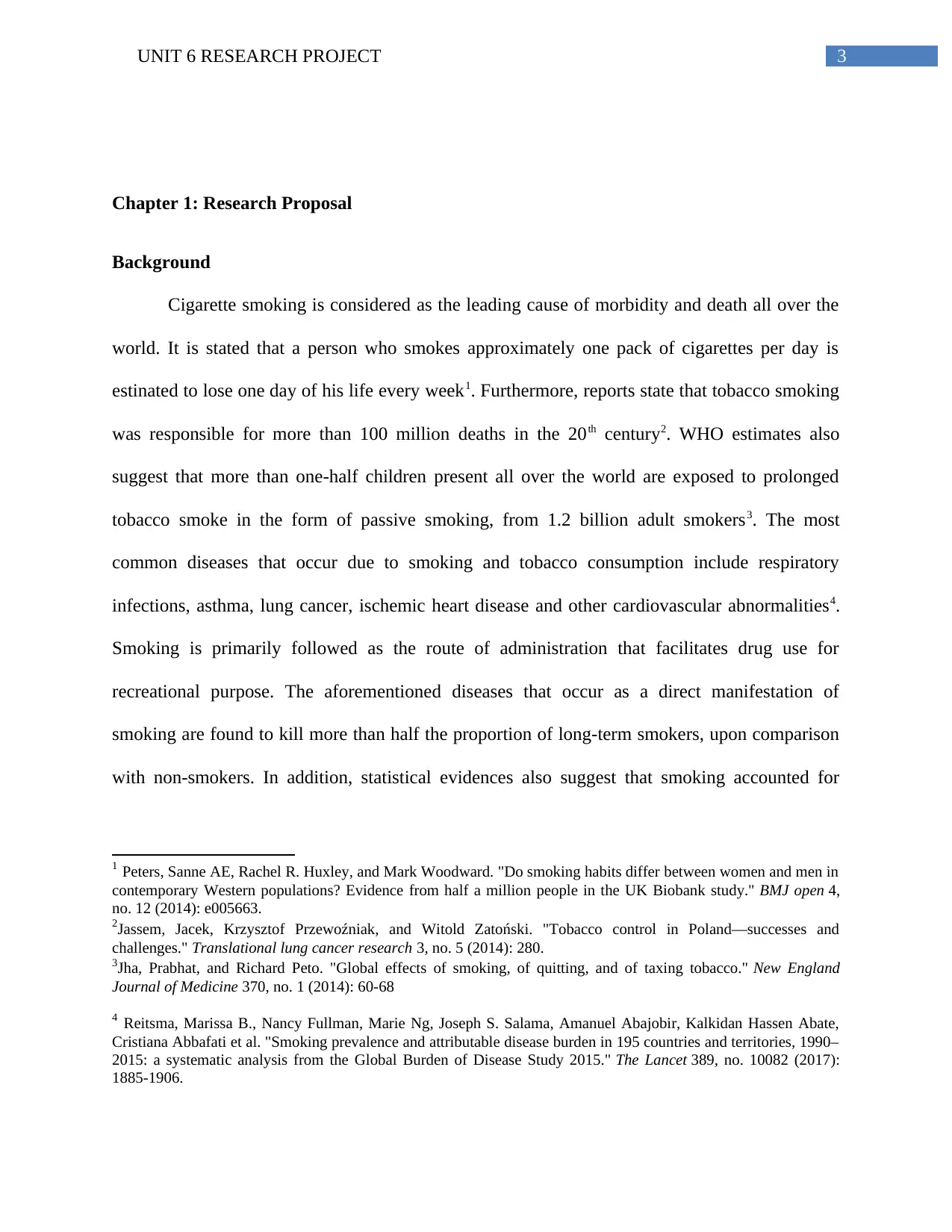
3UNIT 6 RESEARCH PROJECT
Chapter 1: Research Proposal
Background
Cigarette smoking is considered as the leading cause of morbidity and death all over the
world. It is stated that a person who smokes approximately one pack of cigarettes per day is
estinated to lose one day of his life every week1. Furthermore, reports state that tobacco smoking
was responsible for more than 100 million deaths in the 20th century2. WHO estimates also
suggest that more than one-half children present all over the world are exposed to prolonged
tobacco smoke in the form of passive smoking, from 1.2 billion adult smokers3. The most
common diseases that occur due to smoking and tobacco consumption include respiratory
infections, asthma, lung cancer, ischemic heart disease and other cardiovascular abnormalities4.
Smoking is primarily followed as the route of administration that facilitates drug use for
recreational purpose. The aforementioned diseases that occur as a direct manifestation of
smoking are found to kill more than half the proportion of long-term smokers, upon comparison
with non-smokers. In addition, statistical evidences also suggest that smoking accounted for
1 Peters, Sanne AE, Rachel R. Huxley, and Mark Woodward. "Do smoking habits differ between women and men in
contemporary Western populations? Evidence from half a million people in the UK Biobank study." BMJ open 4,
no. 12 (2014): e005663.
2Jassem, Jacek, Krzysztof Przewoźniak, and Witold Zatoński. "Tobacco control in Poland—successes and
challenges." Translational lung cancer research 3, no. 5 (2014): 280.
3Jha, Prabhat, and Richard Peto. "Global effects of smoking, of quitting, and of taxing tobacco." New England
Journal of Medicine 370, no. 1 (2014): 60-68
4 Reitsma, Marissa B., Nancy Fullman, Marie Ng, Joseph S. Salama, Amanuel Abajobir, Kalkidan Hassen Abate,
Cristiana Abbafati et al. "Smoking prevalence and attributable disease burden in 195 countries and territories, 1990–
2015: a systematic analysis from the Global Burden of Disease Study 2015." The Lancet 389, no. 10082 (2017):
1885-1906.
Chapter 1: Research Proposal
Background
Cigarette smoking is considered as the leading cause of morbidity and death all over the
world. It is stated that a person who smokes approximately one pack of cigarettes per day is
estinated to lose one day of his life every week1. Furthermore, reports state that tobacco smoking
was responsible for more than 100 million deaths in the 20th century2. WHO estimates also
suggest that more than one-half children present all over the world are exposed to prolonged
tobacco smoke in the form of passive smoking, from 1.2 billion adult smokers3. The most
common diseases that occur due to smoking and tobacco consumption include respiratory
infections, asthma, lung cancer, ischemic heart disease and other cardiovascular abnormalities4.
Smoking is primarily followed as the route of administration that facilitates drug use for
recreational purpose. The aforementioned diseases that occur as a direct manifestation of
smoking are found to kill more than half the proportion of long-term smokers, upon comparison
with non-smokers. In addition, statistical evidences also suggest that smoking accounted for
1 Peters, Sanne AE, Rachel R. Huxley, and Mark Woodward. "Do smoking habits differ between women and men in
contemporary Western populations? Evidence from half a million people in the UK Biobank study." BMJ open 4,
no. 12 (2014): e005663.
2Jassem, Jacek, Krzysztof Przewoźniak, and Witold Zatoński. "Tobacco control in Poland—successes and
challenges." Translational lung cancer research 3, no. 5 (2014): 280.
3Jha, Prabhat, and Richard Peto. "Global effects of smoking, of quitting, and of taxing tobacco." New England
Journal of Medicine 370, no. 1 (2014): 60-68
4 Reitsma, Marissa B., Nancy Fullman, Marie Ng, Joseph S. Salama, Amanuel Abajobir, Kalkidan Hassen Abate,
Cristiana Abbafati et al. "Smoking prevalence and attributable disease burden in 195 countries and territories, 1990–
2015: a systematic analysis from the Global Burden of Disease Study 2015." The Lancet 389, no. 10082 (2017):
1885-1906.
Paraphrase This Document
Need a fresh take? Get an instant paraphrase of this document with our AI Paraphraser
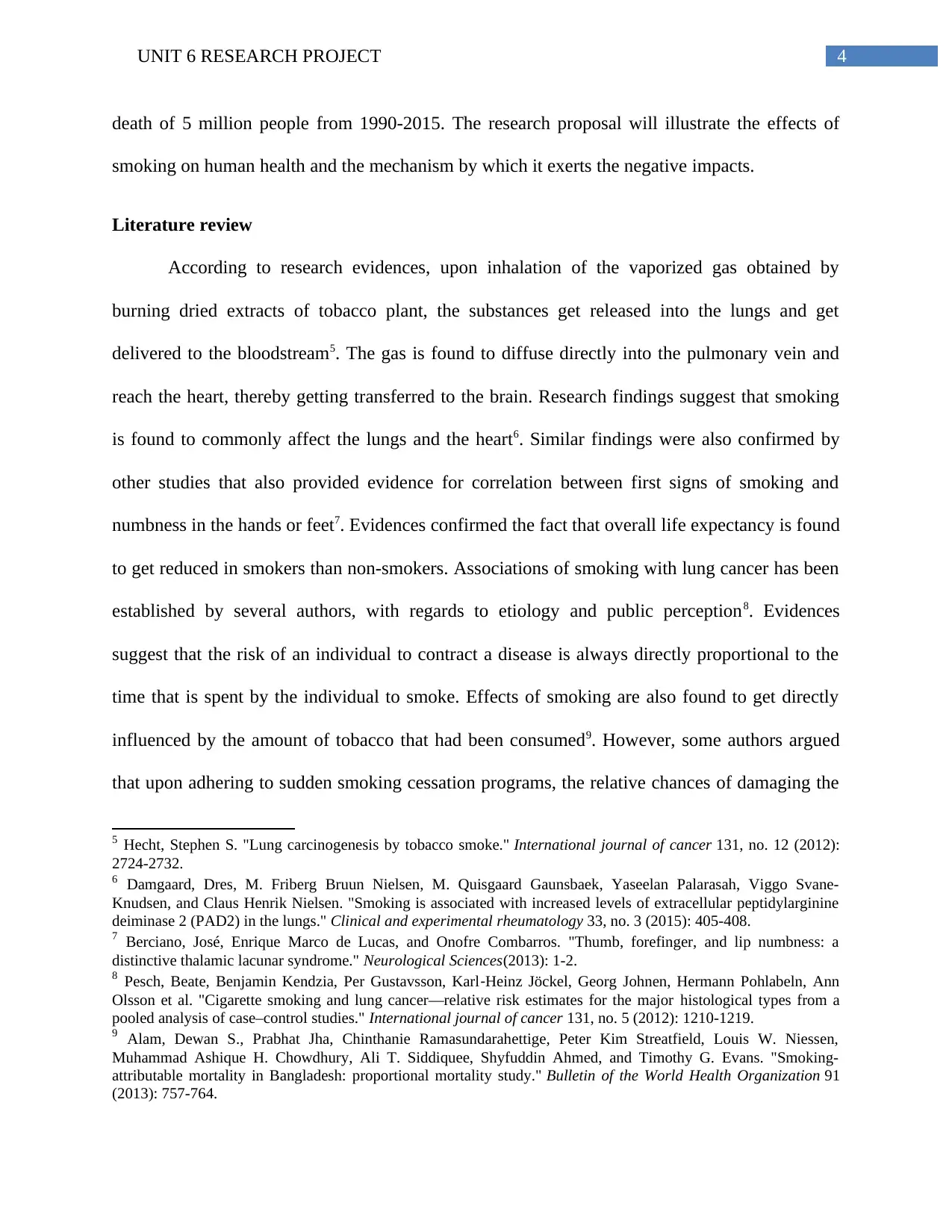
4UNIT 6 RESEARCH PROJECT
death of 5 million people from 1990-2015. The research proposal will illustrate the effects of
smoking on human health and the mechanism by which it exerts the negative impacts.
Literature review
According to research evidences, upon inhalation of the vaporized gas obtained by
burning dried extracts of tobacco plant, the substances get released into the lungs and get
delivered to the bloodstream5. The gas is found to diffuse directly into the pulmonary vein and
reach the heart, thereby getting transferred to the brain. Research findings suggest that smoking
is found to commonly affect the lungs and the heart6. Similar findings were also confirmed by
other studies that also provided evidence for correlation between first signs of smoking and
numbness in the hands or feet7. Evidences confirmed the fact that overall life expectancy is found
to get reduced in smokers than non-smokers. Associations of smoking with lung cancer has been
established by several authors, with regards to etiology and public perception8. Evidences
suggest that the risk of an individual to contract a disease is always directly proportional to the
time that is spent by the individual to smoke. Effects of smoking are also found to get directly
influenced by the amount of tobacco that had been consumed9. However, some authors argued
that upon adhering to sudden smoking cessation programs, the relative chances of damaging the
5 Hecht, Stephen S. "Lung carcinogenesis by tobacco smoke." International journal of cancer 131, no. 12 (2012):
2724-2732.
6 Damgaard, Dres, M. Friberg Bruun Nielsen, M. Quisgaard Gaunsbaek, Yaseelan Palarasah, Viggo Svane-
Knudsen, and Claus Henrik Nielsen. "Smoking is associated with increased levels of extracellular peptidylarginine
deiminase 2 (PAD2) in the lungs." Clinical and experimental rheumatology 33, no. 3 (2015): 405-408.
7 Berciano, José, Enrique Marco de Lucas, and Onofre Combarros. "Thumb, forefinger, and lip numbness: a
distinctive thalamic lacunar syndrome." Neurological Sciences(2013): 1-2.
8 Pesch, Beate, Benjamin Kendzia, Per Gustavsson, Karl‐Heinz Jöckel, Georg Johnen, Hermann Pohlabeln, Ann
Olsson et al. "Cigarette smoking and lung cancer—relative risk estimates for the major histological types from a
pooled analysis of case–control studies." International journal of cancer 131, no. 5 (2012): 1210-1219.
9 Alam, Dewan S., Prabhat Jha, Chinthanie Ramasundarahettige, Peter Kim Streatfield, Louis W. Niessen,
Muhammad Ashique H. Chowdhury, Ali T. Siddiquee, Shyfuddin Ahmed, and Timothy G. Evans. "Smoking-
attributable mortality in Bangladesh: proportional mortality study." Bulletin of the World Health Organization 91
(2013): 757-764.
death of 5 million people from 1990-2015. The research proposal will illustrate the effects of
smoking on human health and the mechanism by which it exerts the negative impacts.
Literature review
According to research evidences, upon inhalation of the vaporized gas obtained by
burning dried extracts of tobacco plant, the substances get released into the lungs and get
delivered to the bloodstream5. The gas is found to diffuse directly into the pulmonary vein and
reach the heart, thereby getting transferred to the brain. Research findings suggest that smoking
is found to commonly affect the lungs and the heart6. Similar findings were also confirmed by
other studies that also provided evidence for correlation between first signs of smoking and
numbness in the hands or feet7. Evidences confirmed the fact that overall life expectancy is found
to get reduced in smokers than non-smokers. Associations of smoking with lung cancer has been
established by several authors, with regards to etiology and public perception8. Evidences
suggest that the risk of an individual to contract a disease is always directly proportional to the
time that is spent by the individual to smoke. Effects of smoking are also found to get directly
influenced by the amount of tobacco that had been consumed9. However, some authors argued
that upon adhering to sudden smoking cessation programs, the relative chances of damaging the
5 Hecht, Stephen S. "Lung carcinogenesis by tobacco smoke." International journal of cancer 131, no. 12 (2012):
2724-2732.
6 Damgaard, Dres, M. Friberg Bruun Nielsen, M. Quisgaard Gaunsbaek, Yaseelan Palarasah, Viggo Svane-
Knudsen, and Claus Henrik Nielsen. "Smoking is associated with increased levels of extracellular peptidylarginine
deiminase 2 (PAD2) in the lungs." Clinical and experimental rheumatology 33, no. 3 (2015): 405-408.
7 Berciano, José, Enrique Marco de Lucas, and Onofre Combarros. "Thumb, forefinger, and lip numbness: a
distinctive thalamic lacunar syndrome." Neurological Sciences(2013): 1-2.
8 Pesch, Beate, Benjamin Kendzia, Per Gustavsson, Karl‐Heinz Jöckel, Georg Johnen, Hermann Pohlabeln, Ann
Olsson et al. "Cigarette smoking and lung cancer—relative risk estimates for the major histological types from a
pooled analysis of case–control studies." International journal of cancer 131, no. 5 (2012): 1210-1219.
9 Alam, Dewan S., Prabhat Jha, Chinthanie Ramasundarahettige, Peter Kim Streatfield, Louis W. Niessen,
Muhammad Ashique H. Chowdhury, Ali T. Siddiquee, Shyfuddin Ahmed, and Timothy G. Evans. "Smoking-
attributable mortality in Bangladesh: proportional mortality study." Bulletin of the World Health Organization 91
(2013): 757-764.
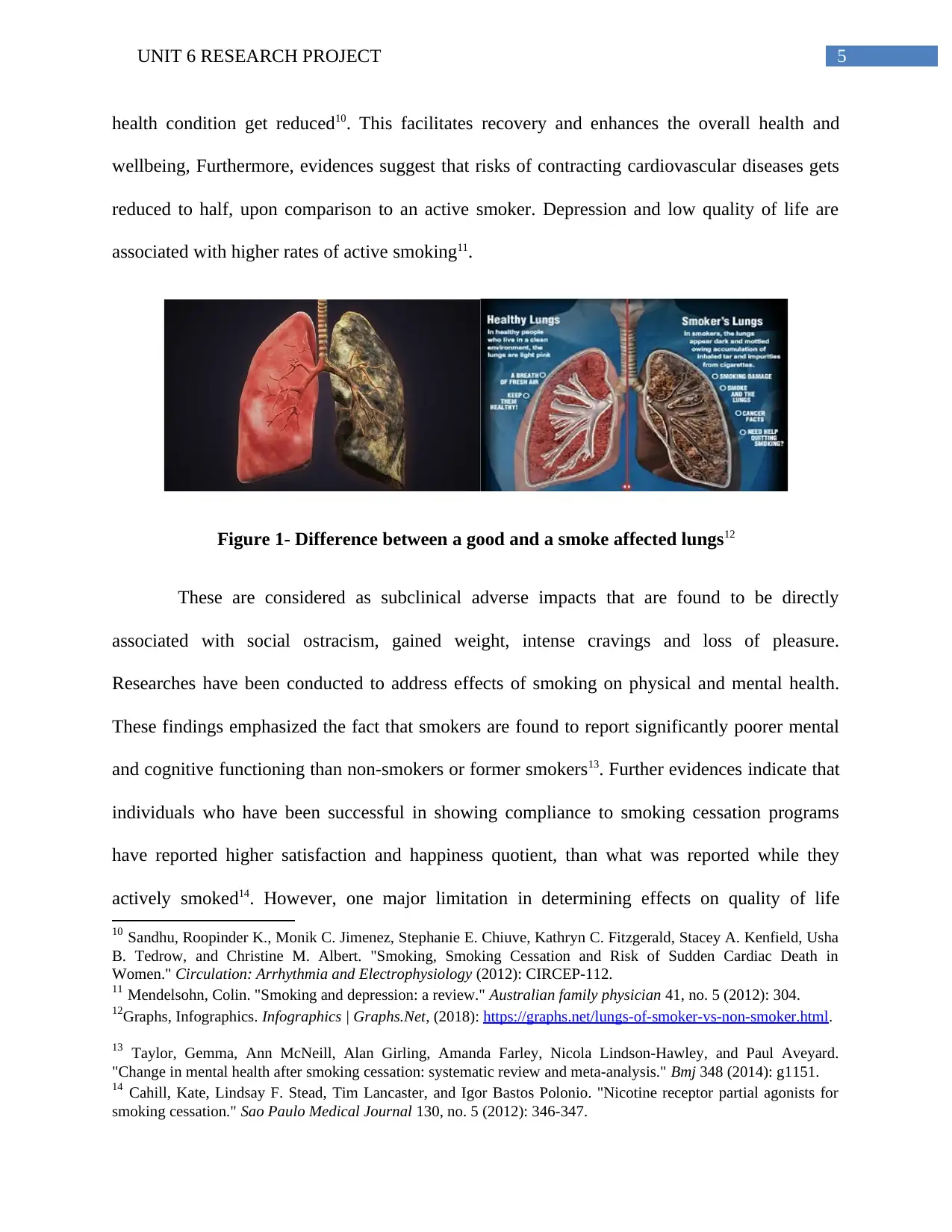
5UNIT 6 RESEARCH PROJECT
health condition get reduced10. This facilitates recovery and enhances the overall health and
wellbeing, Furthermore, evidences suggest that risks of contracting cardiovascular diseases gets
reduced to half, upon comparison to an active smoker. Depression and low quality of life are
associated with higher rates of active smoking11.
Figure 1- Difference between a good and a smoke affected lungs12
These are considered as subclinical adverse impacts that are found to be directly
associated with social ostracism, gained weight, intense cravings and loss of pleasure.
Researches have been conducted to address effects of smoking on physical and mental health.
These findings emphasized the fact that smokers are found to report significantly poorer mental
and cognitive functioning than non-smokers or former smokers13. Further evidences indicate that
individuals who have been successful in showing compliance to smoking cessation programs
have reported higher satisfaction and happiness quotient, than what was reported while they
actively smoked14. However, one major limitation in determining effects on quality of life
10 Sandhu, Roopinder K., Monik C. Jimenez, Stephanie E. Chiuve, Kathryn C. Fitzgerald, Stacey A. Kenfield, Usha
B. Tedrow, and Christine M. Albert. "Smoking, Smoking Cessation and Risk of Sudden Cardiac Death in
Women." Circulation: Arrhythmia and Electrophysiology (2012): CIRCEP-112.
11 Mendelsohn, Colin. "Smoking and depression: a review." Australian family physician 41, no. 5 (2012): 304.
12Graphs, Infographics. Infographics | Graphs.Net, (2018): https://graphs.net/lungs-of-smoker-vs-non-smoker.html.
13 Taylor, Gemma, Ann McNeill, Alan Girling, Amanda Farley, Nicola Lindson-Hawley, and Paul Aveyard.
"Change in mental health after smoking cessation: systematic review and meta-analysis." Bmj 348 (2014): g1151.
14 Cahill, Kate, Lindsay F. Stead, Tim Lancaster, and Igor Bastos Polonio. "Nicotine receptor partial agonists for
smoking cessation." Sao Paulo Medical Journal 130, no. 5 (2012): 346-347.
health condition get reduced10. This facilitates recovery and enhances the overall health and
wellbeing, Furthermore, evidences suggest that risks of contracting cardiovascular diseases gets
reduced to half, upon comparison to an active smoker. Depression and low quality of life are
associated with higher rates of active smoking11.
Figure 1- Difference between a good and a smoke affected lungs12
These are considered as subclinical adverse impacts that are found to be directly
associated with social ostracism, gained weight, intense cravings and loss of pleasure.
Researches have been conducted to address effects of smoking on physical and mental health.
These findings emphasized the fact that smokers are found to report significantly poorer mental
and cognitive functioning than non-smokers or former smokers13. Further evidences indicate that
individuals who have been successful in showing compliance to smoking cessation programs
have reported higher satisfaction and happiness quotient, than what was reported while they
actively smoked14. However, one major limitation in determining effects on quality of life
10 Sandhu, Roopinder K., Monik C. Jimenez, Stephanie E. Chiuve, Kathryn C. Fitzgerald, Stacey A. Kenfield, Usha
B. Tedrow, and Christine M. Albert. "Smoking, Smoking Cessation and Risk of Sudden Cardiac Death in
Women." Circulation: Arrhythmia and Electrophysiology (2012): CIRCEP-112.
11 Mendelsohn, Colin. "Smoking and depression: a review." Australian family physician 41, no. 5 (2012): 304.
12Graphs, Infographics. Infographics | Graphs.Net, (2018): https://graphs.net/lungs-of-smoker-vs-non-smoker.html.
13 Taylor, Gemma, Ann McNeill, Alan Girling, Amanda Farley, Nicola Lindson-Hawley, and Paul Aveyard.
"Change in mental health after smoking cessation: systematic review and meta-analysis." Bmj 348 (2014): g1151.
14 Cahill, Kate, Lindsay F. Stead, Tim Lancaster, and Igor Bastos Polonio. "Nicotine receptor partial agonists for
smoking cessation." Sao Paulo Medical Journal 130, no. 5 (2012): 346-347.
⊘ This is a preview!⊘
Do you want full access?
Subscribe today to unlock all pages.

Trusted by 1+ million students worldwide
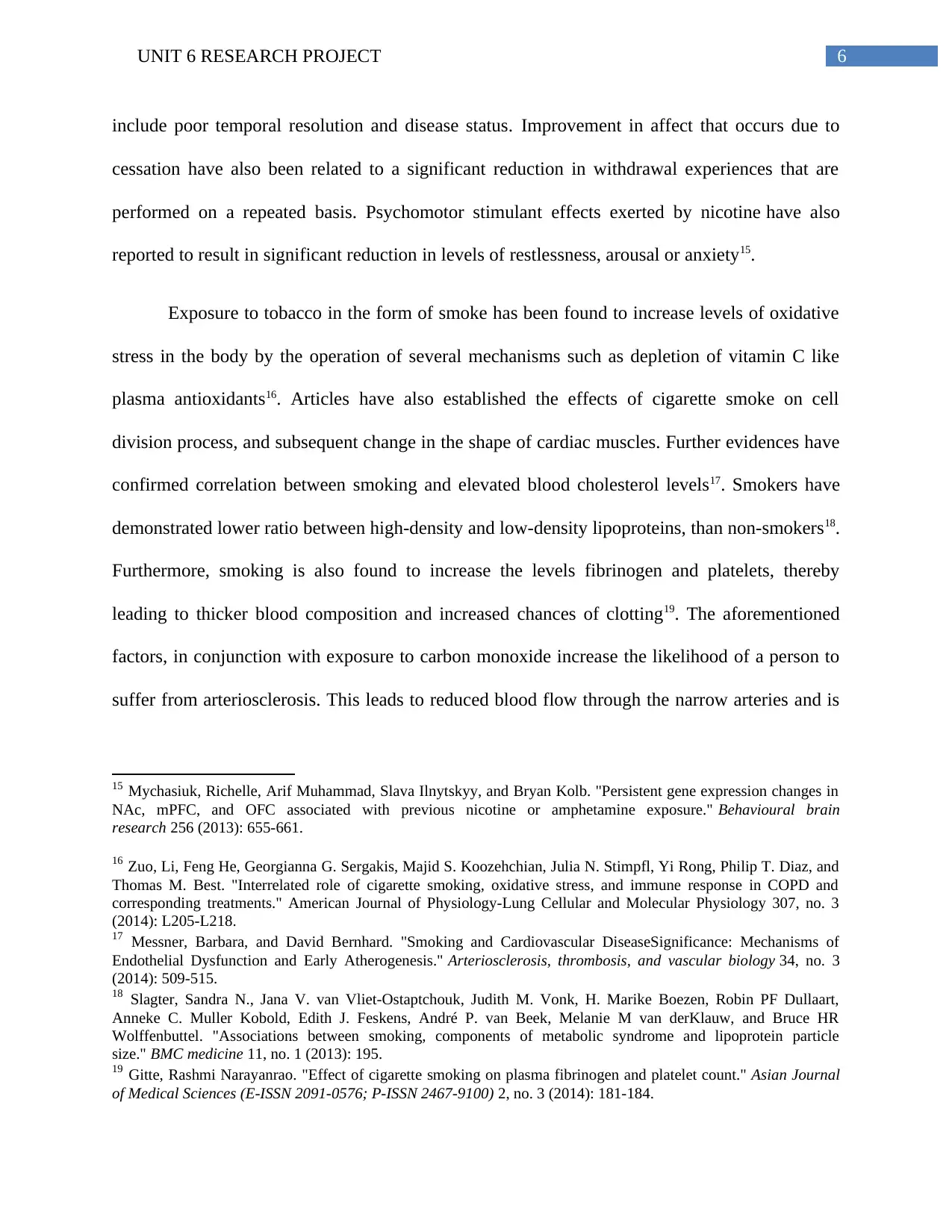
6UNIT 6 RESEARCH PROJECT
include poor temporal resolution and disease status. Improvement in affect that occurs due to
cessation have also been related to a significant reduction in withdrawal experiences that are
performed on a repeated basis. Psychomotor stimulant effects exerted by nicotine have also
reported to result in significant reduction in levels of restlessness, arousal or anxiety15.
Exposure to tobacco in the form of smoke has been found to increase levels of oxidative
stress in the body by the operation of several mechanisms such as depletion of vitamin C like
plasma antioxidants16. Articles have also established the effects of cigarette smoke on cell
division process, and subsequent change in the shape of cardiac muscles. Further evidences have
confirmed correlation between smoking and elevated blood cholesterol levels17. Smokers have
demonstrated lower ratio between high-density and low-density lipoproteins, than non-smokers18.
Furthermore, smoking is also found to increase the levels fibrinogen and platelets, thereby
leading to thicker blood composition and increased chances of clotting19. The aforementioned
factors, in conjunction with exposure to carbon monoxide increase the likelihood of a person to
suffer from arteriosclerosis. This leads to reduced blood flow through the narrow arteries and is
15 Mychasiuk, Richelle, Arif Muhammad, Slava Ilnytskyy, and Bryan Kolb. "Persistent gene expression changes in
NAc, mPFC, and OFC associated with previous nicotine or amphetamine exposure." Behavioural brain
research 256 (2013): 655-661.
16 Zuo, Li, Feng He, Georgianna G. Sergakis, Majid S. Koozehchian, Julia N. Stimpfl, Yi Rong, Philip T. Diaz, and
Thomas M. Best. "Interrelated role of cigarette smoking, oxidative stress, and immune response in COPD and
corresponding treatments." American Journal of Physiology-Lung Cellular and Molecular Physiology 307, no. 3
(2014): L205-L218.
17 Messner, Barbara, and David Bernhard. "Smoking and Cardiovascular DiseaseSignificance: Mechanisms of
Endothelial Dysfunction and Early Atherogenesis." Arteriosclerosis, thrombosis, and vascular biology 34, no. 3
(2014): 509-515.
18 Slagter, Sandra N., Jana V. van Vliet-Ostaptchouk, Judith M. Vonk, H. Marike Boezen, Robin PF Dullaart,
Anneke C. Muller Kobold, Edith J. Feskens, André P. van Beek, Melanie M van derKlauw, and Bruce HR
Wolffenbuttel. "Associations between smoking, components of metabolic syndrome and lipoprotein particle
size." BMC medicine 11, no. 1 (2013): 195.
19 Gitte, Rashmi Narayanrao. "Effect of cigarette smoking on plasma fibrinogen and platelet count." Asian Journal
of Medical Sciences (E-ISSN 2091-0576; P-ISSN 2467-9100) 2, no. 3 (2014): 181-184.
include poor temporal resolution and disease status. Improvement in affect that occurs due to
cessation have also been related to a significant reduction in withdrawal experiences that are
performed on a repeated basis. Psychomotor stimulant effects exerted by nicotine have also
reported to result in significant reduction in levels of restlessness, arousal or anxiety15.
Exposure to tobacco in the form of smoke has been found to increase levels of oxidative
stress in the body by the operation of several mechanisms such as depletion of vitamin C like
plasma antioxidants16. Articles have also established the effects of cigarette smoke on cell
division process, and subsequent change in the shape of cardiac muscles. Further evidences have
confirmed correlation between smoking and elevated blood cholesterol levels17. Smokers have
demonstrated lower ratio between high-density and low-density lipoproteins, than non-smokers18.
Furthermore, smoking is also found to increase the levels fibrinogen and platelets, thereby
leading to thicker blood composition and increased chances of clotting19. The aforementioned
factors, in conjunction with exposure to carbon monoxide increase the likelihood of a person to
suffer from arteriosclerosis. This leads to reduced blood flow through the narrow arteries and is
15 Mychasiuk, Richelle, Arif Muhammad, Slava Ilnytskyy, and Bryan Kolb. "Persistent gene expression changes in
NAc, mPFC, and OFC associated with previous nicotine or amphetamine exposure." Behavioural brain
research 256 (2013): 655-661.
16 Zuo, Li, Feng He, Georgianna G. Sergakis, Majid S. Koozehchian, Julia N. Stimpfl, Yi Rong, Philip T. Diaz, and
Thomas M. Best. "Interrelated role of cigarette smoking, oxidative stress, and immune response in COPD and
corresponding treatments." American Journal of Physiology-Lung Cellular and Molecular Physiology 307, no. 3
(2014): L205-L218.
17 Messner, Barbara, and David Bernhard. "Smoking and Cardiovascular DiseaseSignificance: Mechanisms of
Endothelial Dysfunction and Early Atherogenesis." Arteriosclerosis, thrombosis, and vascular biology 34, no. 3
(2014): 509-515.
18 Slagter, Sandra N., Jana V. van Vliet-Ostaptchouk, Judith M. Vonk, H. Marike Boezen, Robin PF Dullaart,
Anneke C. Muller Kobold, Edith J. Feskens, André P. van Beek, Melanie M van derKlauw, and Bruce HR
Wolffenbuttel. "Associations between smoking, components of metabolic syndrome and lipoprotein particle
size." BMC medicine 11, no. 1 (2013): 195.
19 Gitte, Rashmi Narayanrao. "Effect of cigarette smoking on plasma fibrinogen and platelet count." Asian Journal
of Medical Sciences (E-ISSN 2091-0576; P-ISSN 2467-9100) 2, no. 3 (2014): 181-184.
Paraphrase This Document
Need a fresh take? Get an instant paraphrase of this document with our AI Paraphraser
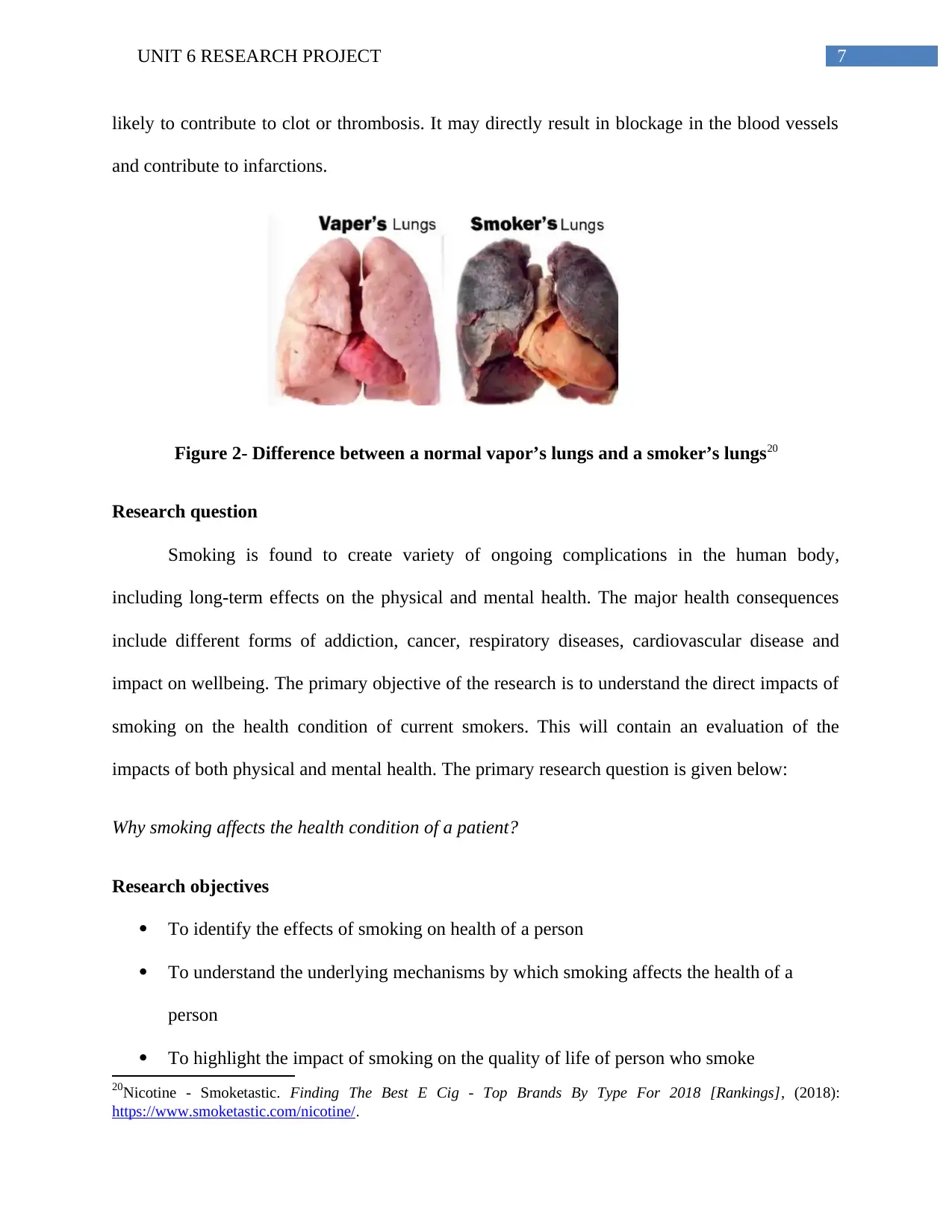
7UNIT 6 RESEARCH PROJECT
likely to contribute to clot or thrombosis. It may directly result in blockage in the blood vessels
and contribute to infarctions.
Figure 2- Difference between a normal vapor’s lungs and a smoker’s lungs20
Research question
Smoking is found to create variety of ongoing complications in the human body,
including long-term effects on the physical and mental health. The major health consequences
include different forms of addiction, cancer, respiratory diseases, cardiovascular disease and
impact on wellbeing. The primary objective of the research is to understand the direct impacts of
smoking on the health condition of current smokers. This will contain an evaluation of the
impacts of both physical and mental health. The primary research question is given below:
Why smoking affects the health condition of a patient?
Research objectives
To identify the effects of smoking on health of a person
To understand the underlying mechanisms by which smoking affects the health of a
person
To highlight the impact of smoking on the quality of life of person who smoke
20Nicotine - Smoketastic. Finding The Best E Cig - Top Brands By Type For 2018 [Rankings], (2018):
https://www.smoketastic.com/nicotine/.
likely to contribute to clot or thrombosis. It may directly result in blockage in the blood vessels
and contribute to infarctions.
Figure 2- Difference between a normal vapor’s lungs and a smoker’s lungs20
Research question
Smoking is found to create variety of ongoing complications in the human body,
including long-term effects on the physical and mental health. The major health consequences
include different forms of addiction, cancer, respiratory diseases, cardiovascular disease and
impact on wellbeing. The primary objective of the research is to understand the direct impacts of
smoking on the health condition of current smokers. This will contain an evaluation of the
impacts of both physical and mental health. The primary research question is given below:
Why smoking affects the health condition of a patient?
Research objectives
To identify the effects of smoking on health of a person
To understand the underlying mechanisms by which smoking affects the health of a
person
To highlight the impact of smoking on the quality of life of person who smoke
20Nicotine - Smoketastic. Finding The Best E Cig - Top Brands By Type For 2018 [Rankings], (2018):
https://www.smoketastic.com/nicotine/.

8UNIT 6 RESEARCH PROJECT
Methodology
The purpose of the study will be to assess the impact or effects of smoking on the
physical and mental health of smokers. Furthermore, it will also investigate the mechanism by
which nicotine, the principle chemical compound of tobacco affects or disrupts the physiological
system of smokers. The study will involve two phases, a qualitative and a quantitative one. The
qualitative part of the research design will be based on conduction of an exhaustive systematic
review that will facilitate collection and critical analysis of multiple research studies that address
the aforementioned research objectives. The systematic review will help in providing a
comprehensive summary of current and relevant literature. This will involve creating a structured
question (the research questions stated above) that will guide the review. The second step will
involve performing a thorough search of journals and databases for extracting relevant articles.
The methodology section present in the systematic review will contain a list of all databases that
have been searched for article retrieval.
The abstracts and titles of each selected article will be checked against a set of pre-
determined inclusion and exclusion criteria to determine their relevance and eligibility. The
PRISMA statement will be used to assign an objective assessment for determining the
methodological quality. Thus, a qualitative approach will be followed for the systematic review
to adhere to a set of standards for collection, gathering and reporting of data. The PRISMA
statement will act as a standardized way of ensuring a complete and transparent reporting of the
articles included in the review. Thus, the first part of the research design will be based on
secondary research that will involve summary, collation and synthesis of already existing
primary research data.
Methodology
The purpose of the study will be to assess the impact or effects of smoking on the
physical and mental health of smokers. Furthermore, it will also investigate the mechanism by
which nicotine, the principle chemical compound of tobacco affects or disrupts the physiological
system of smokers. The study will involve two phases, a qualitative and a quantitative one. The
qualitative part of the research design will be based on conduction of an exhaustive systematic
review that will facilitate collection and critical analysis of multiple research studies that address
the aforementioned research objectives. The systematic review will help in providing a
comprehensive summary of current and relevant literature. This will involve creating a structured
question (the research questions stated above) that will guide the review. The second step will
involve performing a thorough search of journals and databases for extracting relevant articles.
The methodology section present in the systematic review will contain a list of all databases that
have been searched for article retrieval.
The abstracts and titles of each selected article will be checked against a set of pre-
determined inclusion and exclusion criteria to determine their relevance and eligibility. The
PRISMA statement will be used to assign an objective assessment for determining the
methodological quality. Thus, a qualitative approach will be followed for the systematic review
to adhere to a set of standards for collection, gathering and reporting of data. The PRISMA
statement will act as a standardized way of ensuring a complete and transparent reporting of the
articles included in the review. Thus, the first part of the research design will be based on
secondary research that will involve summary, collation and synthesis of already existing
primary research data.
⊘ This is a preview!⊘
Do you want full access?
Subscribe today to unlock all pages.

Trusted by 1+ million students worldwide
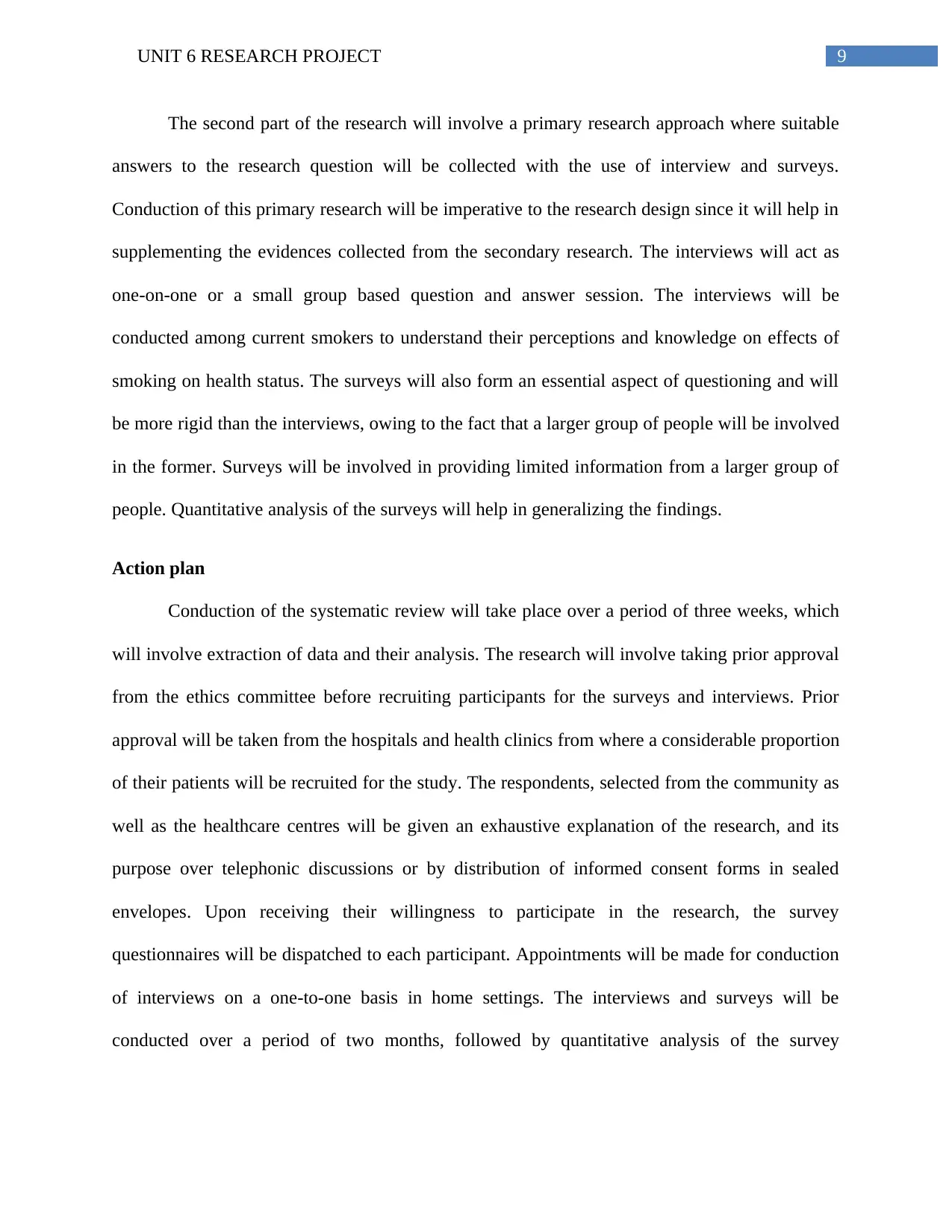
9UNIT 6 RESEARCH PROJECT
The second part of the research will involve a primary research approach where suitable
answers to the research question will be collected with the use of interview and surveys.
Conduction of this primary research will be imperative to the research design since it will help in
supplementing the evidences collected from the secondary research. The interviews will act as
one-on-one or a small group based question and answer session. The interviews will be
conducted among current smokers to understand their perceptions and knowledge on effects of
smoking on health status. The surveys will also form an essential aspect of questioning and will
be more rigid than the interviews, owing to the fact that a larger group of people will be involved
in the former. Surveys will be involved in providing limited information from a larger group of
people. Quantitative analysis of the surveys will help in generalizing the findings.
Action plan
Conduction of the systematic review will take place over a period of three weeks, which
will involve extraction of data and their analysis. The research will involve taking prior approval
from the ethics committee before recruiting participants for the surveys and interviews. Prior
approval will be taken from the hospitals and health clinics from where a considerable proportion
of their patients will be recruited for the study. The respondents, selected from the community as
well as the healthcare centres will be given an exhaustive explanation of the research, and its
purpose over telephonic discussions or by distribution of informed consent forms in sealed
envelopes. Upon receiving their willingness to participate in the research, the survey
questionnaires will be dispatched to each participant. Appointments will be made for conduction
of interviews on a one-to-one basis in home settings. The interviews and surveys will be
conducted over a period of two months, followed by quantitative analysis of the survey
The second part of the research will involve a primary research approach where suitable
answers to the research question will be collected with the use of interview and surveys.
Conduction of this primary research will be imperative to the research design since it will help in
supplementing the evidences collected from the secondary research. The interviews will act as
one-on-one or a small group based question and answer session. The interviews will be
conducted among current smokers to understand their perceptions and knowledge on effects of
smoking on health status. The surveys will also form an essential aspect of questioning and will
be more rigid than the interviews, owing to the fact that a larger group of people will be involved
in the former. Surveys will be involved in providing limited information from a larger group of
people. Quantitative analysis of the surveys will help in generalizing the findings.
Action plan
Conduction of the systematic review will take place over a period of three weeks, which
will involve extraction of data and their analysis. The research will involve taking prior approval
from the ethics committee before recruiting participants for the surveys and interviews. Prior
approval will be taken from the hospitals and health clinics from where a considerable proportion
of their patients will be recruited for the study. The respondents, selected from the community as
well as the healthcare centres will be given an exhaustive explanation of the research, and its
purpose over telephonic discussions or by distribution of informed consent forms in sealed
envelopes. Upon receiving their willingness to participate in the research, the survey
questionnaires will be dispatched to each participant. Appointments will be made for conduction
of interviews on a one-to-one basis in home settings. The interviews and surveys will be
conducted over a period of two months, followed by quantitative analysis of the survey
Paraphrase This Document
Need a fresh take? Get an instant paraphrase of this document with our AI Paraphraser
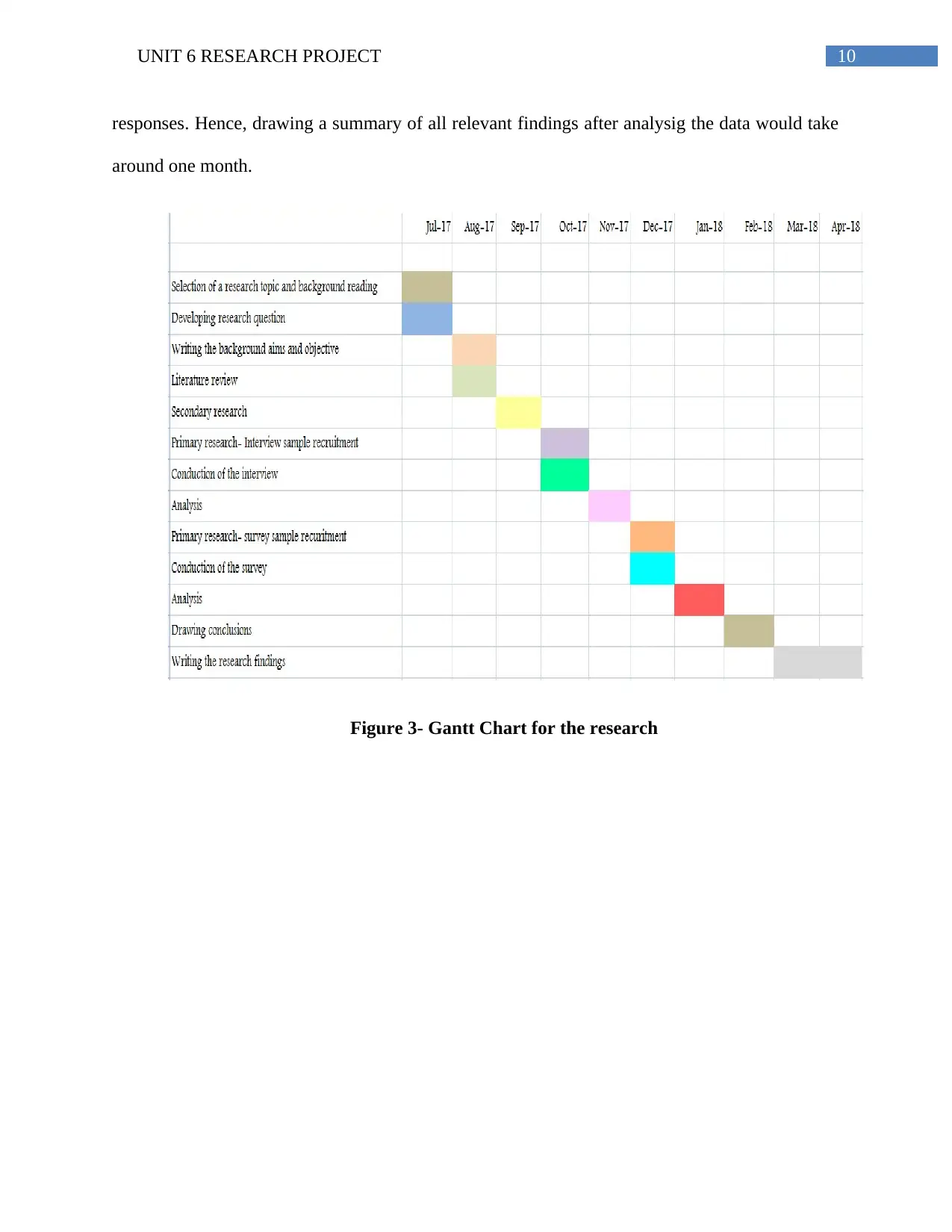
10UNIT 6 RESEARCH PROJECT
responses. Hence, drawing a summary of all relevant findings after analysig the data would take
around one month.
Figure 3- Gantt Chart for the research
responses. Hence, drawing a summary of all relevant findings after analysig the data would take
around one month.
Figure 3- Gantt Chart for the research

11UNIT 6 RESEARCH PROJECT
Chapter 2: Secondary research
As smoking is found to have deleterious long term impact on health, the main aim of
secondary research is to understand the mechanism by which smoke has an impact on health of
current smokers and review the impact of smoking on quality of life of people. Hence, by means
of systematic review method, the first part of the research focused on identifying and analyzing
existing research on effects on smoking on health of an individual. The systematic review of
relevant research articles were done based on the following methodological approach:
Objective of systematic review:
To understand different impact of smoking on health of a person
To understand the mechanism by which smoke has an impact on lungs of individuals
To review the deleterious effect of smoking on quality of life of smokers
To gain an understanding regarding steps needed to improve smoking cessation program
Methods:
PRISMA is an evidence based tool to improve the reporting of systematic reviews and
the PRISMA guidelines were followed for this review too.
Data extraction and search strategy:
Relevant articles related to the research question were taken from health and biomedical
databases like PubMed, Cochrane Library, CINAHL and Science Direct. All these are
exceptional databases that cover citations and provide access to research in the area of life
science, behavioral science and health science. The key search terms that were used to retrieve
articles included ‘cigarette smoking and health’, ‘’impact of cigarette smoking on health’ and
Chapter 2: Secondary research
As smoking is found to have deleterious long term impact on health, the main aim of
secondary research is to understand the mechanism by which smoke has an impact on health of
current smokers and review the impact of smoking on quality of life of people. Hence, by means
of systematic review method, the first part of the research focused on identifying and analyzing
existing research on effects on smoking on health of an individual. The systematic review of
relevant research articles were done based on the following methodological approach:
Objective of systematic review:
To understand different impact of smoking on health of a person
To understand the mechanism by which smoke has an impact on lungs of individuals
To review the deleterious effect of smoking on quality of life of smokers
To gain an understanding regarding steps needed to improve smoking cessation program
Methods:
PRISMA is an evidence based tool to improve the reporting of systematic reviews and
the PRISMA guidelines were followed for this review too.
Data extraction and search strategy:
Relevant articles related to the research question were taken from health and biomedical
databases like PubMed, Cochrane Library, CINAHL and Science Direct. All these are
exceptional databases that cover citations and provide access to research in the area of life
science, behavioral science and health science. The key search terms that were used to retrieve
articles included ‘cigarette smoking and health’, ‘’impact of cigarette smoking on health’ and
⊘ This is a preview!⊘
Do you want full access?
Subscribe today to unlock all pages.

Trusted by 1+ million students worldwide
1 out of 51
Related Documents
Your All-in-One AI-Powered Toolkit for Academic Success.
+13062052269
info@desklib.com
Available 24*7 on WhatsApp / Email
![[object Object]](/_next/static/media/star-bottom.7253800d.svg)
Unlock your academic potential
Copyright © 2020–2025 A2Z Services. All Rights Reserved. Developed and managed by ZUCOL.





